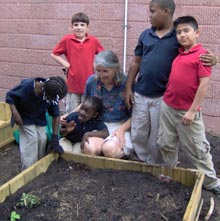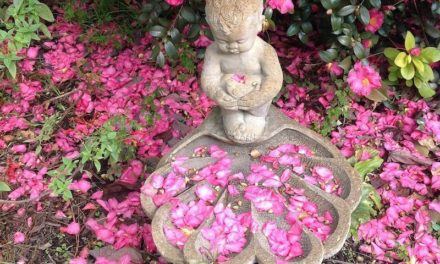 Anyone who gardens in the Lowcountry knows how ready our gardens are to abandon all reserve and turn themselves into rampant, tangled jungle.
Anyone who gardens in the Lowcountry knows how ready our gardens are to abandon all reserve and turn themselves into rampant, tangled jungle.
In no time, the landscape can be consumed by Virginia creeper (Parthenocissus quincefolia), cat briar (Smilax rotundifolia), privet (Ligustrum sinense and L. japonicum), laurel cherry (Prunus caroliniana), wisteria (Wisteria sinense) and countless other species.
Given this tendency for our gardens to revert to jungle, it may seem peculiar that so many gardeners are so deeply fond of the tropical look in the garden. To be sure, the tropical look they’re after isn’t quite the same as the clogging growth of very vigorous species, some native and some exotic, which are constant and pernicious presences in our yards.
Rather, the tropical look so many seek is marked by large, luxuriant foliage; brilliant coloring in foliage, inflorescence, fruit, or all three; and by exotic appearance, looking very unlike the more typical azaleas, camellias, and daylilies of our temperate and subtropical gardens.
There are a number of plants that fit the bill, plants which are surprisingly hardy in our Lowcountry climate despite their tropical appearance. Still others are tender and unlikely to survive outdoors in our winters, but which still are suitable for placing outside in pots during the warm months – then brought into protected space for getting through the winter.
First, think of the large-leaved plants that suggest a tropical look. Big leaf magnolia (Magnolia macrophylla) is a native tree, not seen that often in gardens, producing leaves that can be two to three feet long and a foot wide, growing as a small tree for a number of years, although they can reputedly reach fifty or sixty feet. On a much smaller scale, there is the handsome shrub, Edgeworthia chrysantha, or paperbush. It, too, has large leaves – not so large as the big leaf magnolia, however – arranged handsomely at the ends of long bare branches. Both the magnolia and the paperbush have attractive flowers, as well.
Crinums, of course, make a dramatic tropical statement in the landscape, and there is hardly a more prolific and hardy large bulb available for the garden.
The beautifully textured leaves of the countless varieties of Hosta are perfect for a tropical-look garden, especially the large-leafed types like Empress Wu or Sum and Substance. Again, the flowers are an extra benefit.
There are a number of bamboos which give a very different texture and appearance in a tropical setting – I especially like the yellow and green striped bamboo, Phyllostachys aureosulcata, and the Buddha’s belly bamboo, Bambusa ventricosa. Bamboos, of course, may be either running or clumping types. The striped bamboo is a running bamboo, so it will want to run all over your yard and the neighbors’ yards unless it is properly kept in check. The Buddha’s belly must be constricted to induce the chubby swellings which give it its name, even though it is a clumping type.
The giant leaves of Alocasia and Colocasia – the elephant ears – immediately evoke the tropical look; their aroid cousins, Caladiums, are smaller and more colorful. All are great for this purpose.
It may surprise many gardeners, but there are tropical bromeliads which are hardy enough  to survive most winters in the Lowcountry. The beautiful Queen’s Tears, Billbergia nutans, has survived and bloomed faithfully outside for many years in my gardens in Beaufort County and in Barnwell County much farther inland.
to survive most winters in the Lowcountry. The beautiful Queen’s Tears, Billbergia nutans, has survived and bloomed faithfully outside for many years in my gardens in Beaufort County and in Barnwell County much farther inland.
Members of the family of gingers are also surprisingly hardy, providing large and showy foliage, unusual and beautiful flowers, and dramatic presence in the garden. Of particular interest may be Alpinia, shell gingers, Hedychium, butterfly gingers, and Zingiber, true gingers. I’ve become quite fond of the Dancing Lady gingers, Globba spp, which are low-growing and have wonderful, very strange flowers. They can quickly become a little colony of Dancing Ladies, too, as they spread readily.
Bear in mind that many tender, tropical, indoor plants do very well outdoors in our summers. I immediately think of orchids, which seem especially to appreciate exposure to real outside conditions, so long as their basic requirements of proper light and water are met. Rex begonias, with swirling foliage and bright colored leaves and delightful flowers, often do just fine outdoors. The huge-leafed Swiss cheese plant – Monstera deliciosa, often mistakenly called “philodendron – with the highly dissected tropical leaves, can be a vigorous vine outside. The Snake Plant, Sansevieria spp, and even African violets, Saintpaulia, can make a splash in the garden, too.
With these tender houseplants, it is imperative to remember that they are vulnerable; be sure to care for them at least as carefully as they are cared for inside. Most of these I keep in pots even outdoors, making it easier to bring them back inside once they need the protection of climate control.
A tropical-style garden can be created relatively easily in the Lowcountry. It may not have the grandeur of a design by Roberto Burle Marx, but luxuriant foliage and eye-catching blooms – combined with our muggy, hot summers – may make the garden feel like a hike in Costa Rica.







